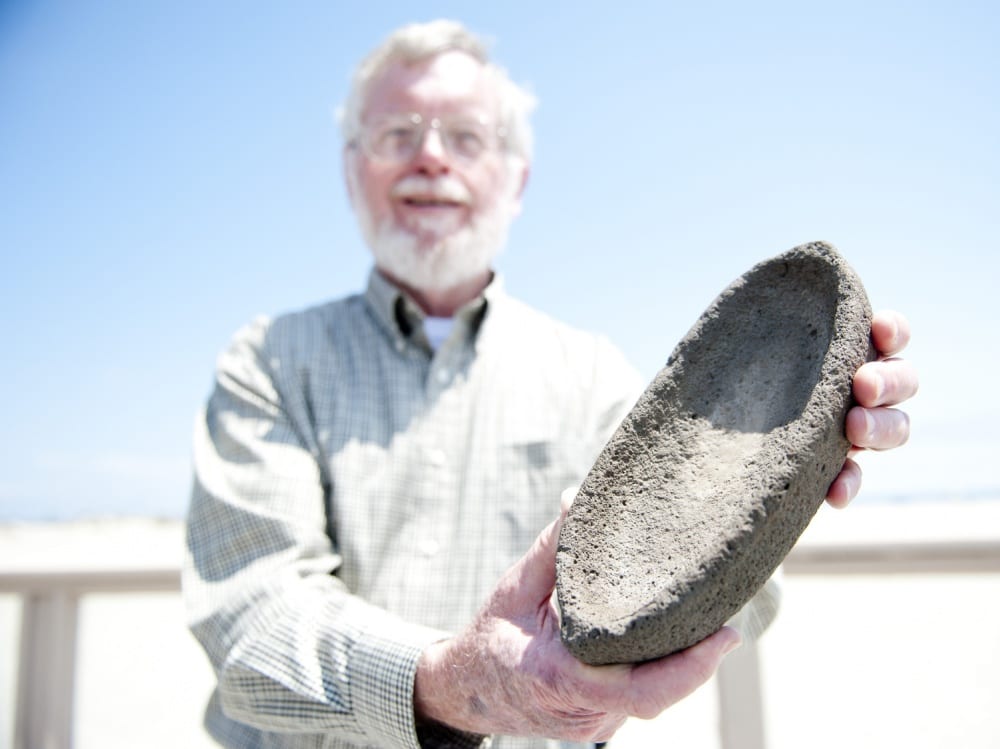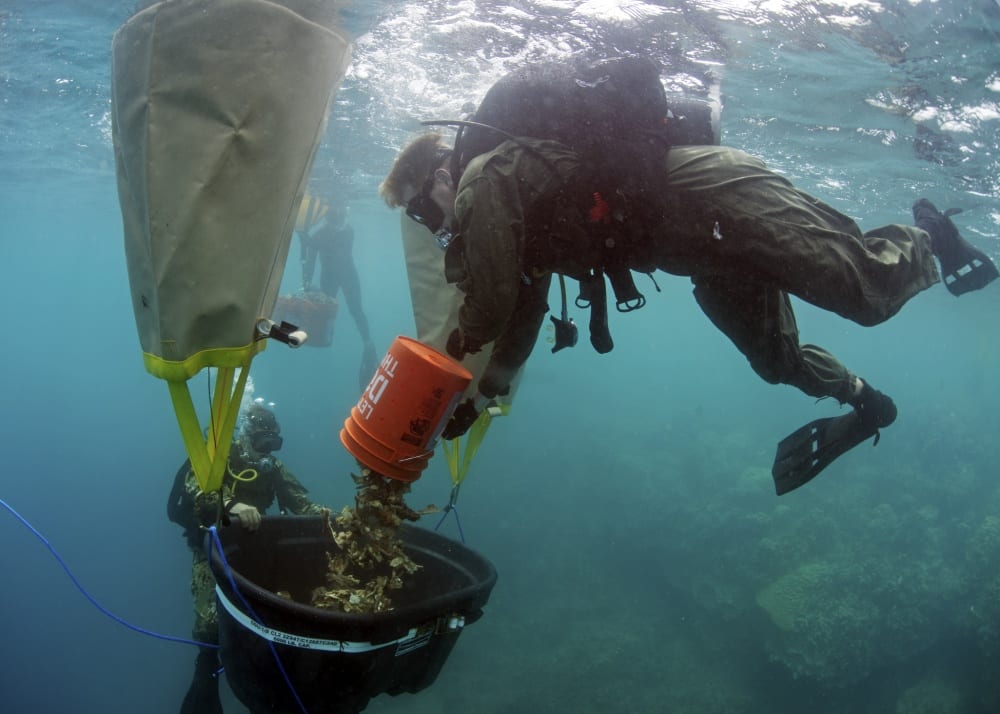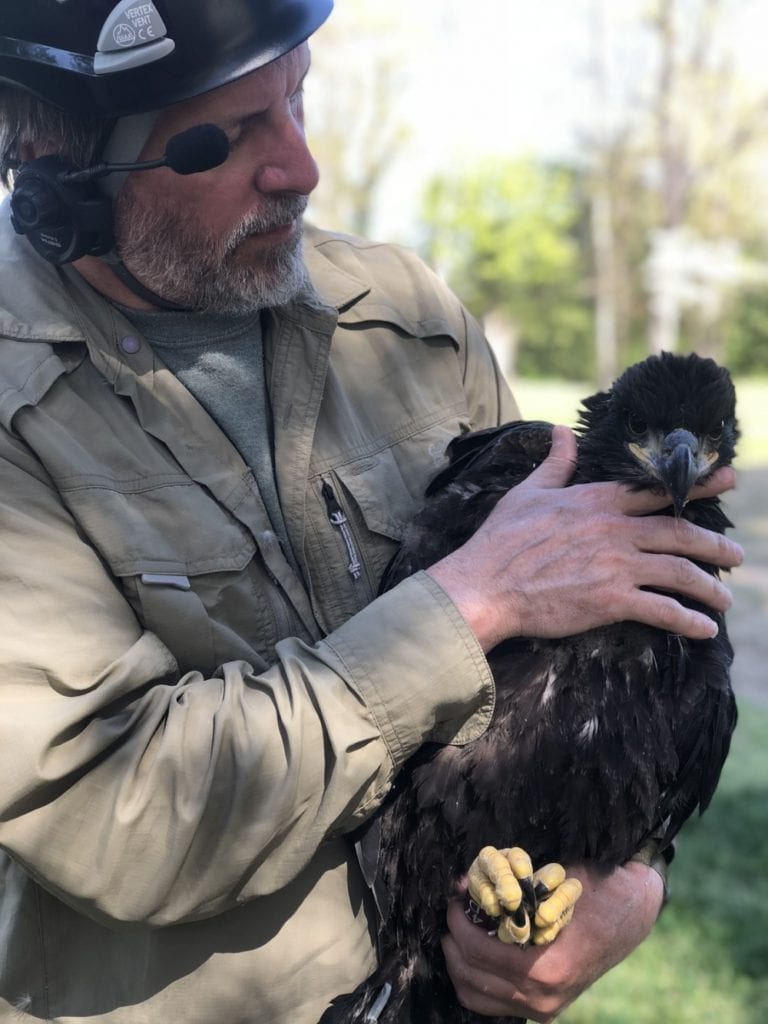
The Department of the Navy is steward to some of America’s most precious archeological sites as well as natural habitats for migratory and endangered species.
On the archeological front, there are some spectacular examples. At Naval Air Weapons Station China Lake, California, the public can see one of the largest collections of Native American Rock Art at Little Petroglyph Canyon, where more than 6,000 images were left by the ancient Coso people of California.
The Foxtrot Petroglyph Site at Marine Corps Air Ground Combat Center, Twentynine Palms, California, is listed in the National Register of Historic Places, and has a variety of different types of rock art, including both petroglyphs (images created through pecking, scratching, or rubbing onto the stone surface) and pictographs (images painted onto stone) at the same site.
Naval Base Pearl Harbor is the site of ancient native Hawaiian fishponds, such as the Okiokiolepe Fishpond, listed in the National Register of Historic Places.
Numerous other prehistoric archeological sites in the Western U.S. are protected by the Navy at Naval Air Station (NAS) Fallon, Nevada, NAS Whidbey Island, Washington and NAS North Island, California, and other installations.
Artifacts at the Posey Site at Naval Surface Weapons Center, Indian Head, Maryland, provide evidence of intensive Indian trade with Europeans. NAS Pensacola is the site of one of the earliest European settlements in Florida, Santa Maria de Galve, established in 1698.
As these examples indicate, Navy and Marine Corps installations are often established located on lands previously occupied by various cultures and ethnic groups in the past.
“It is DoN policy to locate and identify these sites, which number in the tens of thousands, and to protect them and any artifacts and collections that may be excavated or erode from them,” said W. Brock During, environmental program director for Commander, Navy Installations Command.

Moving coral
The Department of the Navy is also steward of a number of sensitive ecological areas, and being a good environmental steward also means restoring, protecting and enhancing the quality of the environment for current and future generations.
In fiscal year 2021, Joint Region Marianas (JRM) expects to spend millions for conservation projects, primarily associated with military construction, military training and ungulate management. For example, a wharf improvement project at Apra Harbor on U.S. Naval Base Guam involves relocation of approximately 4,500 coral colonies. Future projects include plans to relocate an additional 150,000 coral colonies.
The Navy and other DoD services partner with other federal, state and local partners, specifically U.S. Department of Agriculture Animal and Plant Health Inspection Service Wildlife Services, to coordinate and conduct brown tree snake inspections of all units and their equipment that come to the Mariana Islands to train. Brown tree snakes are an invasive species that can wipe out native birds and animals.
Ungulate fencing projects on military installations on Guam is protecting native habitats from two specific non-native invasive species — feral pigs and deer — which destroy natural vegetation, increase rates of erosion, contribute to the loss of native plant and animal species and increase the spread of invasive plants.
JRM is working to protect the endangered Serianthes nelsonii, commonly known as the fire tree, endemic to Guam and the Commonwealth of the Northern Mariana Islands. Guam’s only mature Serianthes nelsonii tree is located on Andersen Air Force Base. The preservation efforts, including the planting of numerous saplings, are aimed at increasing the Serianthes nelsonii population conserving Guam’s unique limestone forests. JRM’s habitat conservation and watershed management activities are helping to reduce erosion and improve water quality.
“Taking a proactive approach to protecting the region’s natural and cultural resources remains a priority for DoD,” said Rear Adm. John Menoni, JRM commander. “We recognize that the stewardship of the region’s cultural and natural resources is a significant responsibility and it is one we take seriously.”
Helping Habitats
In and around Naval District Washington, wildlife biologists at NSF Dahlgren are conducting Atlantic and Shortnose Sturgeon surveys where the fish are being tagged with radio-frequency identification, or RFID transmitters, to track their movements in the Potomac River.
Yearly bird surveys counting Rufus red knots and great blue herons are conducted at NAS Patuxent River’s Bloodsworth Island Range. NSF Dahlgren, NSF Indian Head and NAS Patuxent River have been working together on a five-year survey of tricolored, little brown, Indiana, and northern long-eared bats.
A number of facilities are creating pollinator habitats to benefit the rusty-patched bumble bee and the monarch butterfly. The bases are also conducting bald eagle and spotted turtle and diamondback terrapin surveys are ongoing at NAS Patuxent River, and NSA Bethesda is conducting species inventories of herpetofauna, small mammals, benthic macroinvertebrates, and avian species.
Naval Station Guantanamo Bay, Cuba, is a safe habitat for endangered species, such as the Hutia, known locally as “banana rats,” Cuban rock iguana and Cuban boa.
In Navy Region Northwest, the restricted access to beaches at Naval Magazine Indian Island at Kilisut Harbor — home to protected bald eagle nests, endangered newts and cougars — and clam harvesting agreements with local tribes have resulted in some of the best tribal clamming in the Puget Sound and Sailish Sea.
One of the largest old growth forests in the “Evergreen State” is the Navy-managed old growth forest at the Jim Creek communications facility and recreation area near Naval Station Everett. The Navy owns the 4,827-acre property, purchased in 1950, but a paper company owned the timber rights. In 1992, the Navy purchased the timber rights to the land it already owned for $3 million, which at that time was the single largest natural resource conservation project ever funded by the DoD.
Working with the San Diego Zoo Wildlife Alliance, California Department of Fish and Wildilfe, U.S. Fish and Wildlife Service (USFWS) and others, the Navy’s California least terns and western snowy plover protection program has protecting nest sites and hatchlings to ensure the survival of these federally protected species.
Once a remote ammo depot, Naval Weapons Station Seal Beach is now surrounded by dense urban development, yet this base, located in the Los Angeles metropolitan area, is the only military installation that has a National Wildlife Refuge completely enclosed within the fence line. The 965 acres of coastal wetlands has been a sanctuary for local and migratory wildlife since 1972.
In the San Diego Bay, the Navy has partnered the Port of San Diego and nonprofits to improve the natural habitat and expand the eelgrass, a fundamental resource for sustaining life in the bay.

‘We care’
Some wildlife protection programs are simple and low-cost. In 1986, it was estimated that the eastern bluebird population had declined by 90 percent in its historic range over the preceding 50 years due to changes in agriculture practices, competition from invasive bird species and loss of nest sites. So, Alisha Sutton of the U.S. Naval Research Laboratory’s Explosive Safety & Environmental Branch with her colleagues to establish a nest box trail for eastern bluebirds at NRL’s Chesapeake Beach facility.
Most recently, Sutton and her team moved the nest boxes from fencing to stand-alone posts with predator guards to prevent snakes and other predators from getting into the box and eating the young bluebirds.
NRL is also helping the Chesapeake Bay’s oyster population recover. Oysters play a unique role in the health of the bay by their ability to filter water and improve water quality. But in recent years, the bay’s oyster population has declined dramatically because of overharvesting, pollution, disease, and habitat loss, and with it the health of bay’s ecosystem.
NRL is working in partnership with the Chesapeake Beach Oyster Cultivation Society (CBOCS) to cultivate oysters. CBOCS provides tiny oyster “spat” to sink in cages near NRL’s Chesapeake Bay Detachment docks where the oysters can grow. After about a year in this “nursery,” the cages are hauled out of the water, the oysters counted and then taken to deeper water to be spread on a reef.
“The work is as muddy and tedious as it is rewarding,” said Alisha Sutton. “This summer we spread 7,000 matured spat on the reef.
“The Navy has a lot of acreage all over the world,” Sutton said. “We’re members of the community and we’re dedicated to taking good care of the land which are entrusted with. We care about the land, the water and the air in the environment where we are working.”
- A Day to Remember - September 11, 2023
- Indo-Pacific Maritime Security Exchange will examine emerging capabilities and capacity - July 12, 2023
- Cold Waters Spark Warm Relationship - April 20, 2023




